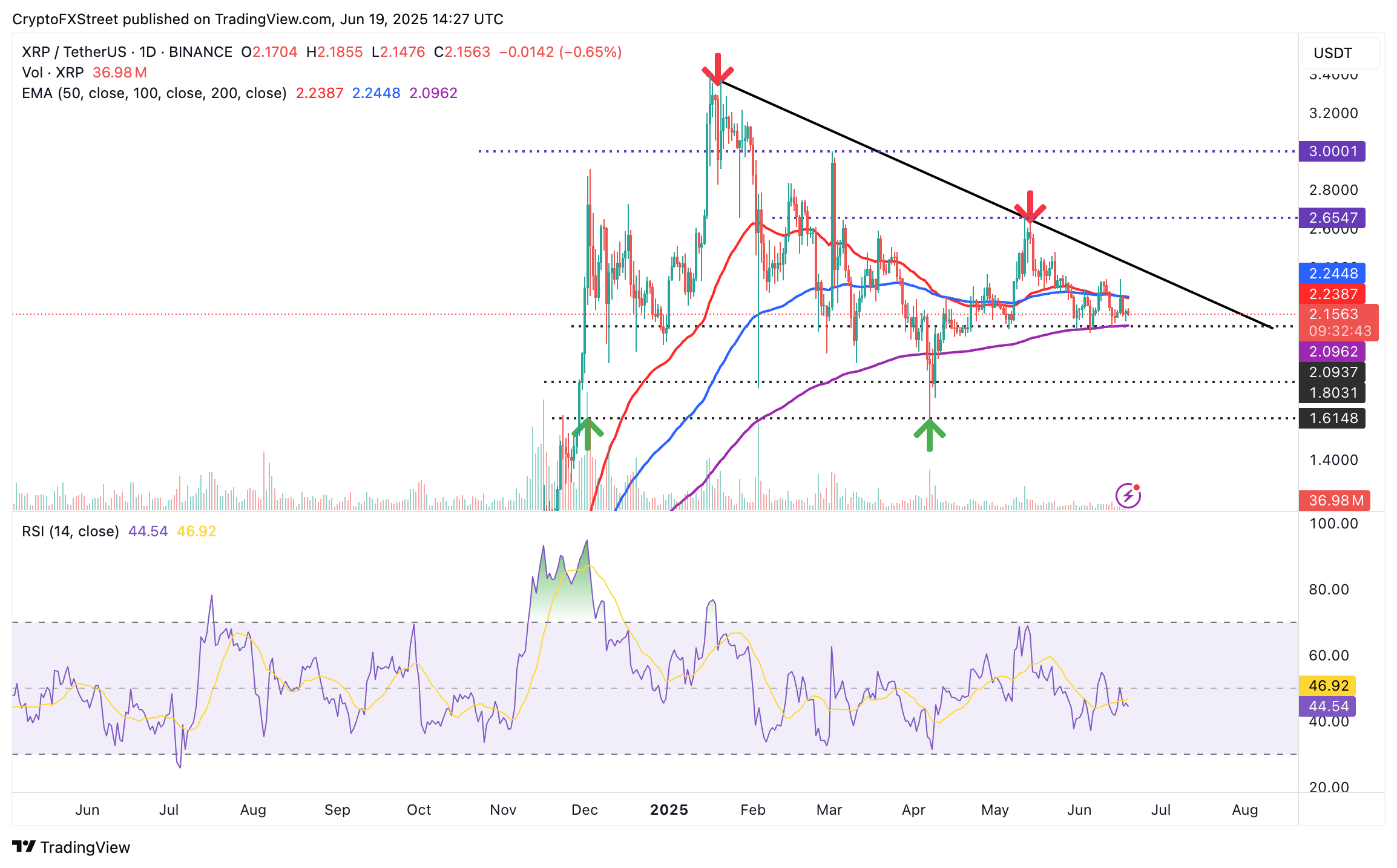Ripple Price Forecast: XRP could slump to $1.80 as Ripple urges the UK to advance stablecoin adoption
- XRP upside price action muted by low market activity, trader indecision and a cautious Fed.
- Ripple urges the UK to prioritize a growth-driven regulatory framework, advance stablecoin adoption and tackle tokenization barriers.
- XRP’s future could be decided by two key levels: The 200-day EMA at $2.09 support and the confluence resistance at $2.24.
Ripple (XRP) has maintained a technical bearish bias, trading at around $2.15 at the time of writing on Thursday. The subdued price action reflects a lull in sentiment in the broader cryptocurrency market, which overshadowed key adoption news on the launch of XRP spot Exchange Traded Funds (ETFs) in Canada on Wednesday.
Interest in cryptocurrencies, including XRP, is largely constrained despite the Federal Reserve (Fed) leaving interest rates unchanged in the range of 4.25% to 4.50% and meeting market expectations. However, the central bank portrayed a hawkish stance, citing potential short-term inflation resulting from tariffs as a key catalyst.
Ripple calls on the UK to advance stablecoin adoption
Ripple believes that the opportunity for the United Kingdom (UK) to become a “world leader in digital assets” is enormous. However, the only way to achieve this is by developing a regulatory framework that facilitates innovation and enhances inclusion.
In a blog post published on Wednesday, Ripple said that it urged the UK government to prioritize clear regulatory frameworks, especially for institutional cryptocurrencies, during the London Policy Summit earlier this year.
The government should move quickly on stablecoin regulation, which will support interoperability with international players. Ripple commended the UK’s proposal to permit foreign-issued stablecoins to circulate, cementing the country as an international financial hub.
The company added that the UK Government and its regulators are making steps toward tokenization standards, which have the potential to “transform the financial markets of the future.”
“With more stablecoin use cases being proven, and tokenised financial assets gaining traction in traditional finance, the UK’s regulatory landscape must evolve now to capitalise on this opportunity and seize the moment to further cement itself as a leader in global finance,” Ripple stated.
The urge for the UK to hasten digital asset-focused regulations comes amid the advancement of the Guidance and Establishing Innovation for US Stablecoins (GENIUS) bill from the United States (US) Senate to the House.
Technical outlook: XRP trades sideways
XRP’s price is trading broadly sideways between support provided by the 200-day Exponential Moving Average (EMA) at $2.09 and a confluence of resistance at $2.24, where the 50-day EMA and the 100-day EMA converge.
The Relative Strength Index (RSI), which has been sliding below the midline, has maintained a bearish bias since its previous peak near overbought territory in mid-May. A continued decline toward oversold areas could keep the path of least resistance downward.
Liquidity at the 200-day EMA support ($2.09) will likely lead to a trend reversal. However, traders cannot rule out the possibility of a prolonged drop to the next support level at $1.80, which was tested in early April.

XRP/USDT daily chart
On the contrary, recovery above the confluence resistance at $2.24 would bring the price of XRP close to the descending trendline resistance, as shown in the chart above. A potential break above this trendline could see interest in XRP return, elevating the bullish scope to $2.65, a hurdle tested in June, and $3.00, which was last tested in March as resistance.
Cryptocurrency prices FAQs
Token launches influence demand and adoption among market participants. Listings on crypto exchanges deepen the liquidity for an asset and add new participants to an asset’s network. This is typically bullish for a digital asset.
A hack is an event in which an attacker captures a large volume of the asset from a DeFi bridge or hot wallet of an exchange or any other crypto platform via exploits, bugs or other methods. The exploiter then transfers these tokens out of the exchange platforms to ultimately sell or swap the assets for other cryptocurrencies or stablecoins. Such events often involve an en masse panic triggering a sell-off in the affected assets.
Macroeconomic events like the US Federal Reserve’s decision on interest rates influence crypto assets mainly through the direct impact they have on the US Dollar. An increase in interest rate typically negatively influences Bitcoin and altcoin prices, and vice versa. If the US Dollar index declines, risk assets and associated leverage for trading gets cheaper, in turn driving crypto prices higher.
Halvings are typically considered bullish events as they slash the block reward in half for miners, constricting the supply of the asset. At consistent demand if the supply reduces, the asset’s price climbs.

